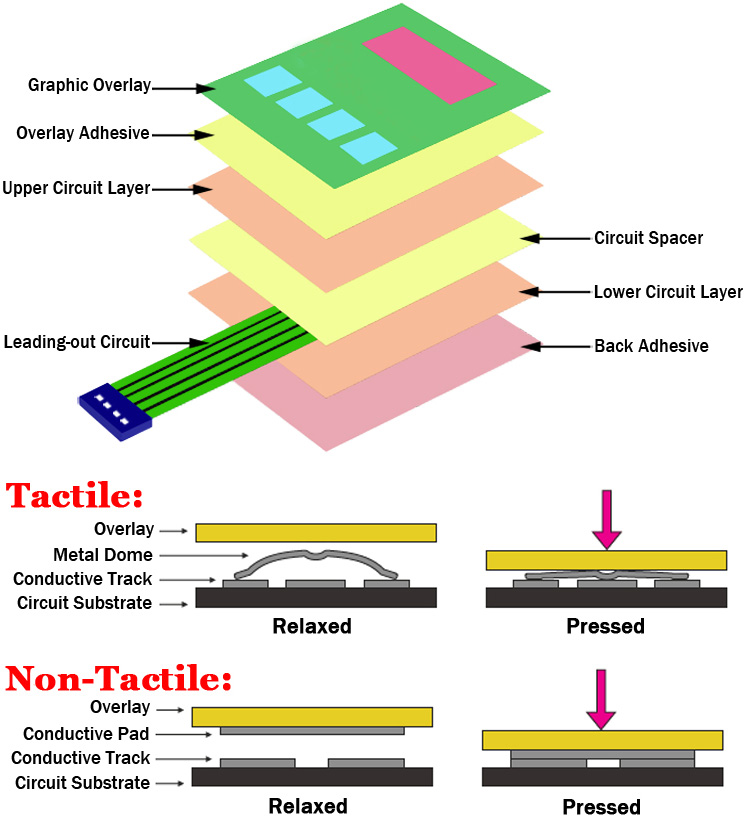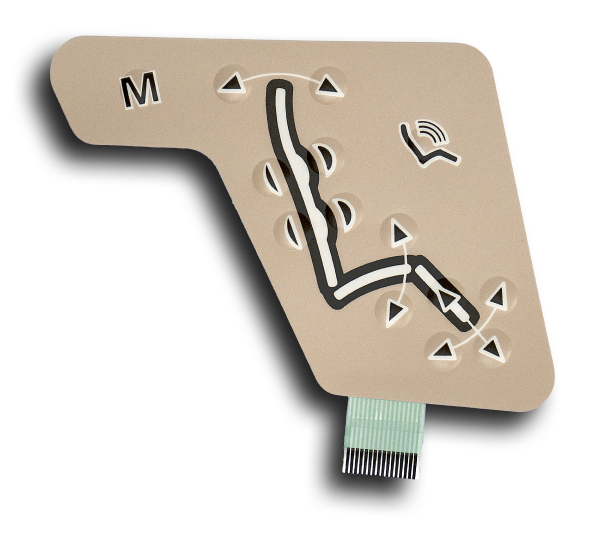The Production Refine Behind Membrane Layer Switch Over: What You Need to Know
The manufacturing process behind membrane switches over combines cautious layout, product choice, and top quality control. It starts with comprehending the details of membrane button style and progresses via various phases, including material choices and printing methods. Each stage plays a crucial duty in guaranteeing capability and resilience. However, the complexities of layer construction and the extensive screening criteria may disclose insights that are not right away evident. What lies beyond these fundamental components?
Understanding Membrane Layer Switch Over Design
Membrane switches might show up straightforward at initial glimpse, their layout involves detailed factors to consider that ensure functionality and longevity. The style procedure begins with a comprehensive understanding of customer requirements, consisting of the interface's designated application and environmental elements. Functional designs is an essential element, as the layout should facilitate simplicity of use while ensuring that tactile feedback satisfies user expectations.Moreover, the layering of elements, such as visuals overlays, sticky layers, and conductive traces, must be precisely crafted. membrane switch. This layered configuration not just influences the switch's responsiveness yet also influences its long life. Interest is offered to the securing strategies utilized to shield against wetness and dust, which could endanger performance. Additionally, layout considerations reach visual appeals, where color systems and visual clarity enhance individual experience. Ultimately, the style of membrane layer switches over balances functionality, customer experience, and longevity, making certain that they meet the needs of various applications effectively
Materials Used in Membrane Change Manufacturing
When selecting materials for membrane button production, it is necessary to contemplate both performance and resilience. The main products consist of polyester and polycarbonate films, which offer versatility and toughness. These movies are frequently covered with adhesive to guarantee proper bonding to substratums. Conductive inks, normally made up of silver or carbon, are vital for developing electrical links within the switch, enabling dependable operation.Additionally, a protective layer, such as a hard coat, is frequently related to boost scratch resistance and long life. The choice of backing material, such as acrylic or foam, can considerably affect the switch's tactile feel and total user experience. Moreover, various environmental elements, including temperature and humidity, need to direct product selection to assure peak performance in certain applications. Ultimately, the right combination of materials adds to the membrane layer button's performance and lifespan, making informed selections crucial for suppliers.
The Printing Refine: Creating Video and Text
The printing procedure in membrane switch production plays a substantial role in creating high-quality graphics and message. Different graphic design techniques are utilized to guarantee aesthetic appeal and performance, while careful ink option methods are crucial for longevity and efficiency. Understanding these components is fundamental for achieving ideal cause membrane switch layout.
Graphic Layout Techniques
Graphic layout methods play a crucial function in the printing process of membrane layer buttons, as they specify just how graphics and message will ultimately appear on the end product. Effective visuals layout involves the tactical use colors, layouts, and typefaces to improve readability and aesthetic appeal. Designers frequently use vector graphics for scalability, making sure that images remain sharp at various sizes. Furthermore, attention to contrast and placement is vital, as it affects user communication and aesthetic top quality. The consolidation of branding aspects, such as logo designs, have to be handled with care to preserve brand name stability. Overall, thoughtful visuals design methods contribute significantly to the capability and good looks of membrane layer buttons, influencing user experience and product efficiency.
Ink Selection Techniques
Selecting the suitable ink is important for attaining the preferred aesthetic quality and durability in membrane button manufacturing. Different ink kinds are utilized, including solvent-based, water-based, and UV-curable inks. Each type offers unique characteristics, such as resistance, adaptability, and attachment to environmental elements. Solvent-based inks are usually favored for their toughness and vivid colors, while water-based inks are extra eco-friendly yet may have limitations in bond. UV-curable inks supply quick treating and robust performance. Furthermore, shade matching strategies assure that the picked inks line up with design specifications. Eventually, the option of ink should consider factors such as application method, substrate compatibility, and end-use demands to accomplish exceptional cause membrane button graphics and message.
Layer Building And Construction and Setting Up

Product Option Refine
A mindful choice of materials is important in the manufacturing procedure of membrane layer buttons, as it directly influences functionality and resilience. The primary products used include polyester, polycarbonate, and various conductive inks. Polyester is typically preferred for its superb resistance to chemicals and abrasion, making it ideal for rough settings. Polycarbonate, on the various other hand, gives superior clarity and influence resistance, which is beneficial for applications requiring visibility and robustness. Conductive inks, typically made up of silver or carbon, are essential for developing trusted electric paths. Furthermore, the choice of adhesive products influences the general stability of the switch - membrane switch. Evaluating factors such as ecological direct exposure, tactile feedback, and visual demands guides producers in picking the very best materials for their certain applications
Layer Bond Strategies
Sticking layers in membrane layer switch construction is an important process that assures performance and durability. Various bond techniques are used to secure excellent bonding between layers, which generally consist of the use of adhesives, warmth, and pressure. Pressure-sensitive adhesives (PSAs) are frequently made use of for their ease of application and prompt bonding capacities. Furthermore, thermal bonding strategies can be used, where warmth is used to trigger adhesive properties, protecting a solid bond. The option of bond technique mainly depends on the materials included and the particular application demands of the membrane switch. Proper alignment and consistent application of adhesives are essential to avoid flaws, securing the button runs efficiently throughout its designated life expectancy.
Quality Assurance Actions
Ensuring high quality control throughout the layer building and construction and assembly of membrane switches is crucial for maintaining performance and integrity. This procedure commonly includes a number of crucial steps, consisting of extensive assessments at each stage of manufacturing. Producers Visit This Link make use of advanced Get the facts screening methods, such as peel tests and adhesion analyses, to confirm the integrity of layer bonds. Additionally, aesthetic assessments are carried out to determine any defects in printing or material variances. Ecological problems, such as temperature level and moisture, are very carefully kept an eye on to assure excellent healing and adhesion. Additionally, regular calibration of equipment aids maintain precise manufacturing criteria. By implementing these quality assurance procedures, producers can considerably decrease the risk of item failure, assuring that the final membrane layer switches fulfill the called for requirements and customer assumptions.
Examining and Top Quality Control Measures

Advancements in Membrane Layer Switch Technology
As innovations in innovation remain to evolve, membrane layer switches are taking advantage of check these guys out cutting-edge advancements that enhance their capability and individual experience. One notable technology is the combination of capacitive touch technology, which permits more receptive and user-friendly interface. This change not only enhances aesthetic appeals but also reduces mechanical wear and tear, extending the life expectancy of the switches.Additionally, advancements in graphic overlay products have actually brought about enhanced longevity and resistance to ecological factors such as wetness and UV light. These materials now supply enhanced quality and brightness, additional boosting the visual appeal.Furthermore, the consolidation of clever technology is changing membrane layer switches right into interactive control board, enabling connectivity with IoT tools. This connectivity cultivates a seamless user experience, leading the means for applications in various markets, from medical care to customer electronics. Collectively, these advancements placement membrane switches as important parts in modern gadget style.
Regularly Asked Inquiries
The length of time Does the Membrane Switch Over Production Refine Take?
The period of the membrane switch manufacturing process can vary significantly. Aspects such as intricacy, products made use of, and manufacturing quantity impact timelines, with typical production ranging from a few days to several weeks for completion.
What Are the Common Applications for Membrane Switches?
Membrane switches are commonly utilized in various industries, including automotive controls, household appliances, clinical tools, and customer electronic devices (membrane switch). Their convenience and longevity make them ideal for applications calling for straightforward user interfaces and trusted efficiency in varied atmospheres
Can Membrane Switches Be Custom-made for Details Requirements?

What Is the Lifespan of a Normal Membrane Layer Switch?
The life expectancy of a normal membrane layer button differs, but typically, it ranges from 1 to 5 million cycles. Aspects such as use, setting, and worldly quality greatly influence sturdiness and general efficiency with time.

Are Membrane Switches Environmentally Pleasant?
The ecological kindness of membrane layer changes varies. Some materials used might not be recyclable, while others can be eco-friendly. The total influence depends upon producing products and methods, requiring careful consideration throughout choice and disposal. The manufacturing process behind membrane layer changes combines cautious design, product choice, and quality control. It starts with comprehending the complexities of membrane button style and progresses via different stages, consisting of material selections and printing methods. When selecting products for membrane layer switch production, it is vital to contemplate both efficiency and sturdiness. A careful choice of materials is crucial in the manufacturing procedure of membrane buttons, as it directly influences performance and resilience. The choice of bond method mainly depends on the materials included and the specific application needs of the membrane button.